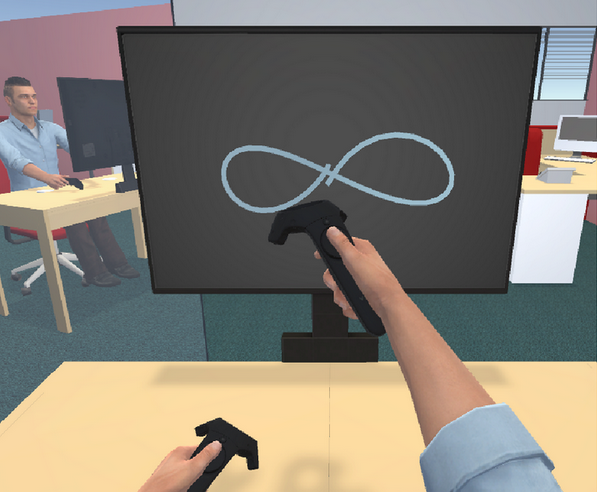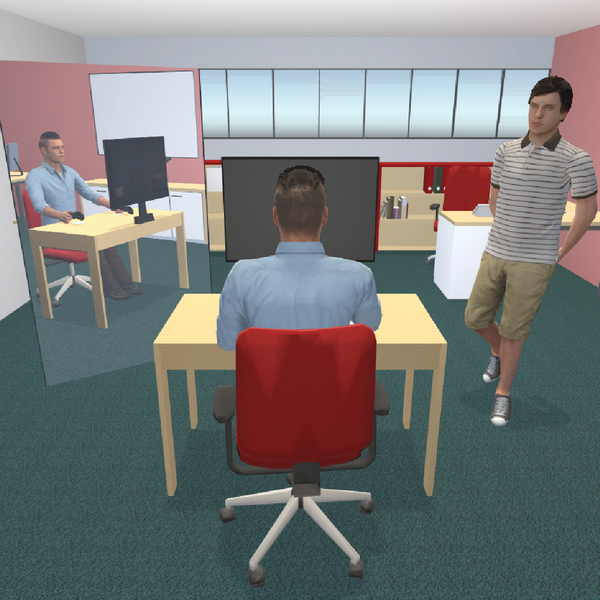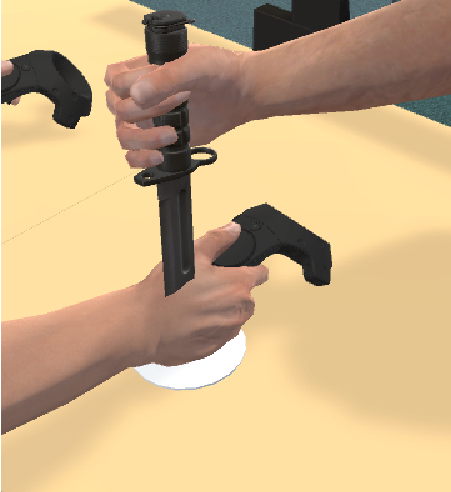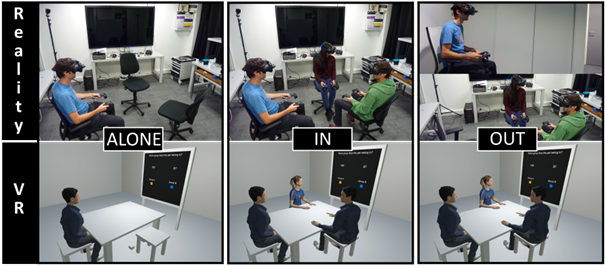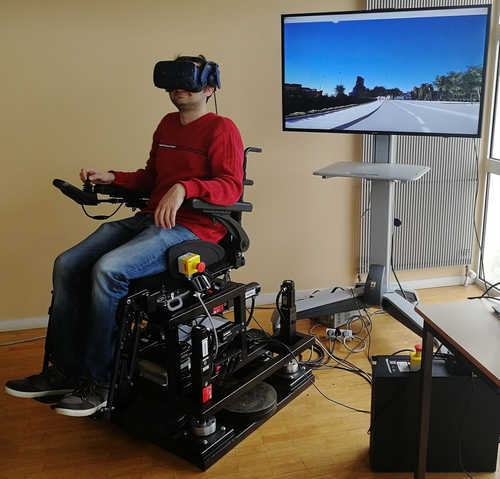Section: New Results
Virtual Reality Tools and Usages
Studying the Mental Effort in Virtual Versus Real Environments
Participants : Tiffany Luong, Ferran Argelaguet, Anatole Lécuyer [contact] .
Is there an effect of Virtual Reality (VR) Head-Mounted Display (HMD) on the user’s mental effort? In this work, we compare the mental effort in VR versus in real environments [26]. An experiment (N=27) was conducted to assess the effect of being immersed in a virtual environment (VE) using a HMD on the user’s mental effort while performing a standardized cognitive task (the wellknown N-back task, with three levels of difficulty (1,2,3)). In addition to test the effect of the environment (i.e., virtual versus real), we also explored the impact of performing a dual task (i.e., sitting versus walking) in both environments on mental effort. The mental effort was assessed through self-reports, task performance, behavioural and physiological measures. In a nutshell, the analysis of all measurements revealed no significant effect of being immersed in the VE on the users’ mental effort. In contrast, natural walking significantly increased the users’ mental effort. Taken together, our results support the fact that there is no specific additional mental effort related to the immersion in a VE using a VR HMD.
Influence of Personality Traits and Body Awareness on the Sense of Embodiment in VR
Participants : Diane Dewez, Rebecca Fribourg, Ferran Argelaguet, Anatole Lécuyer [contact] .
With the increasing use of avatars in virtual reality, it is important to identify the factors eliciting the sense of embodiment. This work reports an exploratory study aiming at identifying internal factors (personality traits and body awareness) that might cause either a resistance or a predisposition to feel a sense of embodiment towards a virtual avatar. To this purpose, we conducted an experiment (n=123) in which participants were immersed in a virtual environment and embodied in a gender-matched generic virtual avatar through a head-mounted display [16]. After an exposure phase in which they had to perform a number of visuomotor tasks, a virtual character entered the virtual scene and stabbed the participants' virtual hand with a knife (see Figure 4). The participants' sense of embodiment was measured, as well as several personality traits (Big Five traits and locus of control) and body awareness, to evaluate the influence of participants' personality on the acceptance of the virtual body. The major finding is that the locus of control is linked to several components of embodiment: the sense of agency is positively correlated with an internal locus of control and the sense of body ownership is positively correlated with an external locus of control. Taken together, our results suggest that the locus of control could be a good predictor of the sense of embodiment. Yet, further studies are required to confirm these results.
This work was done in collaboration with the MimeTIC team.
|
Consumer perceptions and purchase behavior of imperfect fruits and vegetables in VR
Participants : Jean-Marie Normand, Guillaume Moreau [contact] .
This study investigates the effects of fruits and vegetables (FaVs) abnormality on consumer perceptions and purchasing behavior [9]. For the purposes of this study, a virtual grocery store was created with a fresh FaVs section, where 142 participants became immersed using an Oculus Rift DK2 Head-Mounted Display (HMD) software. Participants were presented either normal, slightly misshapen, moderately misshapen or severely misshapen FaVs. The study findings indicate that shoppers tend to purchase a similar number of FaVs whatever their level of deformity. However, perceptions of the appearance and quality of the FaVs depend on the degree of abnormality. Moderately misshapen FaVs are perceived as significantly better than those that are heavily misshapen but also “slightly” misshapen (except for the appearance of fruits).
This work was done in collaboration with Audecia Recherce, the University of Reading and the University of Tokyo.
Am I better in VR with a real audience?
Participants : Romain Terrier, Valérie Gouranton [contact] , Bruno Arnaldi.
We designed an experimental study to investigate the effects of a real audience on social inhibition [33]. The study is a virtual reality (VR) and multiuser application (see Figure 5). The experience is locally or remotely shared. The application engages one user and a real audience (i.e., local or remote conditions). A control condition is designed where the user is alone (i.e., alone condition). The objective performance (i.e., type and answering time) of users, when performing a categorization of numbers task in VR, is used to explore differences between conditions. In addition to this, the perceptions of others, the stress, the cognitive workload, and the presence of each user have been compared in relation to the location of the real audience. The results showed that in the presence of a real audience (in the local and remote conditions), user performance is affected by social inhibitions. Furthermore, users are even more influenced when the audience does not share the same room, despite others are less perceived.
This work was done in collaboration with IRT B COM.
Create by Doing – Action sequencing in VR
Participants : Flavien Lécuyer, Valérie Gouranton [contact] , Adrien Reuzeau, Ronan Gaugne, Bruno Arnaldi.
In every virtual reality application, there are actions to perform, often in a logical order. This logical ordering can be a predefined sequence of actions, enriched with the representation of different possibilities, which we refer to as a scenario. Authoring such a scenario for virtual reality is still a difficult task, as it needs both the expertise from the domain expert and the developer. We propose [28] to let the domain expert create in virtual reality the scenario by herself without coding, through the paradigm of creating by doing (see Figure 6). The domain expert can run an application, record the sequence of actions as a scenario, and then reuse this scenario for other purposes, such as an automatic replay of the scenario by a virtual actor to check the obtained scenario, the injection of this scenario as a constraint or a guide for a trainee, or the monitoring of the scenario unfolding during a procedure.
Help! I Need a Remote Guide in my Mixed Reality Collaborative Environment
Participants : Valérie Gouranton [contact] , Bruno Arnaldi.
The help of a remote expert in performing a maintenance task can be useful in many situations, and can save time as well as money. In this context, augmented reality (AR) technologies can improve remote guidance thanks to the direct overlay of 3D information onto the real world. Furthermore, virtual reality (VR) enables a remote expert to virtually share the place in which the physical maintenance is being carried out. In a traditional local collaboration, collaborators are face-to-face and are observing the same artifact, while being able to communicate verbally and use body language such as gaze direction or facial expression. These interpersonal communication cues are usually limited in remote collaborative maintenance scenarios, in which the agent uses an AR setup while the remote expert uses VR. Providing users with adapted interaction and awareness features to compensate for the lack of essential communication signals is therefore a real challenge for remote MR collaboration. However, this context offers new opportunities for augmenting collaborative abilities, such as sharing an identical point of view, which is not possible in real life. Based on the current task of the maintenance procedure, such as navigation to the correct location or physical manipulation, the remote expert may choose to freely control his/her own viewpoint of the distant workspace, or instead may need to share the viewpoint of the agent in order to better understand the current situation. In this work, we first focus on the navigation task, which is essential to complete the diagnostic phase and to begin the maintenance task in the correct location [8]. We then present a novel interaction paradigm, implemented in an early prototype, in which the guide can show the operator the manipulation gestures required to achieve a physical task that is necessary to perform the maintenance procedure. These concepts are evaluated, allowing us to provide guidelines for future systems targeting efficient remote collaboration in MR environments.
This work was done in collaboration with IRT B COM and UMR Lab-STICC, France.
Learning procedural skills with a VR simulator: An acceptability study
Participants : Valérie Gouranton [contact] , Bruno Arnaldi.
Virtual Reality (VR) simulation has recently been developed and has improved surgical training. Most VR simulators focus on learning technical skills and few on procedural skills. Studies that evaluated VR simulators focused on feasibility, reliability or easiness of use, but few of them used a specific acceptability measurement tool. The aim of the study was to assess acceptability and usability of a new VR simulator for procedural skill training among scrub nurses, based on the Unified Theory of Acceptance and Use of Technology (UTAUT) model. The simulator training system was tested with a convenience sample of 16 non-expert users and 13 expert scrub nurses from the neurosurgery department of a French University Hospital. The scenario was designed to train scrub nurses in the preparation of the instrumentation table for a craniotomy in the operating room (OR). Acceptability of the VR simulator was demonstrated with no significant difference between expert scrub nurses and non-experts. There was no effect of age, gender or expertise. Workload, immersion and simulator sickness were also rated equally by all participants. Most participants stressed its pedagogical interest, fun and realism, but some of them also regretted its lack of visual comfort. This VR simulator designed to teach surgical procedures can be widely used as a tool in initial or vocational training [2], [43].
This work was achieved in collaboration with Univ. Rennes 2-LP3C, LTSI and the Hycomes team.
The Anisotropy of Distance Perception in VR
Participants : Etienne Peillard, Anatole Lécuyer, Ferran Argelaguet, Jean-Marie Normand, Guillaume Moreau [contact] .
The topic of distance perception has been widely investigated in Virtual Reality (VR). However, the vast majority of previous work mainly focused on distance perception of objects placed in front of the observer. Then, what happens when the observer looks on the side? In this work, we study differences in distance estimation when comparing objects placed in front of the observer with objects placed on his side [31]. Through a series of four experiments (n=85), we assessed participants' distance estimation and ruled out potential biases. In particular, we considered the placement of visual stimuli in the field of view, users' exploration behavior as well as the presence of depth cues. For all experiments a two-alternative forced choice (2AFC) standardized psychophysical protocol was employed, in which the main task was to determine the stimuli that seemed to be the farthest one. In summary, our results showed that the orientation of virtual stimuli with respect to the user introduces a distance perception bias: objects placed on the sides are systematically perceived farther away than objects in front. In addition, we could observe that this bias increases along with the angle, and appears to be independent of both the position of the object in the field of view as well as the quality of the virtual scene. This work sheds a new light on one of the specificities of VR environments regarding the wider subject of visual space theory. Our study paves the way for future experiments evaluating the anisotropy of distance perception in real and virtual environments.
Study of Gaze and Body Segments Temporal Reorientation Behaviour in VR
Participants : Hugo Brument, Ferran Argelaguet [contact] .
This work investigates whether the body anticipation synergies in real environments (REs) are preserved during navigation in virtual environments (VEs). Experimental studies related to the control of human locomotion in REs during curved trajectories report a top-down body segments reorientation strategy, with the reorientation of the gaze anticipating the reorientation of head, the shoulders and finally the global body motion [12]. This anticipation behavior provides a stable reference frame to the walker to control and reorient his/her body segments according to the future walking direction. To assess body anticipation during navigation in VEs, we conducted an experiment where participants, wearing a head-mounted display, performed a lemniscate trajectory in a virtual environment (VE) using five different navigation techniques, including walking, virtual steering (head, hand or torso steering) and passive navigation. For the purpose of this experiment, we designed a new control law based on the power-law relation between speed and curvature during human walking. Taken together, our results showed a similar ordered top-down sequence of reorientation of the gaze, head and shoulders during curved trajectories for all the evaluated techniques. However, the anticipation mechanism was significantly higher for the walking condition compared to the others. Finally, the results work pave the way to the better understanding of the underlying mechanisms of human navigation in VEs and to the design of navigation techniques more adapted to humans.
This work was done in collaboration with the MimeTIC team and the Interactive Media Systems Group (TU Wien, Vienna, Austria).
User-centered design of a multisensory power wheelchair simulator
Participants : Guillaume Vailland, Valérie Gouranton [contact] .
Autonomy and social inclusion can reveal themselves everyday challenges for people experiencing mobility impairments. These people can benefit from technical aids such as power wheelchairs to access mobility and overcome social exclusion. However, power wheelchair driving is a challenging task which requires good visual, cognitive and visuo-spatial abilities. Besides, a power wheelchair can cause material damage or represent a danger of injury for others or oneself if not operated safely. Therefore, training and repeated practice are mandatory to acquire safe driving skills to obtain power wheelchair prescription from therapists. However, conventional training programs may reveal themselves insufficient for some people with severe impairments. In this context, Virtual Reality offers the opportunity to design innovative learning and training programs while providing realistic wheelchair driving experience within a virtual environment. In line with this, we propose a user-centered design of a multisensory power wheelchair simulator [34]. This simulator addresses classical virtual experience drawbacks such as cybersickness and sense of presence by combining 3D visual rendering, haptic feedback and motion cues. The simulator was showcased in the SOFMER conference [37].
This work has been done in collaboration with Rainbow team.
Machine Learning Based Interaction Technique Selection For 3D User Interfaces
Participant : Bruno Arnaldi [contact] .
A 3D user interface can be adapted in multiple ways according to each user’s needs, skills and preferences. Such adaptation can consist in changing the user interface layout or its interaction techniques. Personalization systems which are based on user models can automatically determine the configuration of a 3D user interface in order to fit a particular user. In this work, we proposed to explore the use of machine learning in order to propose a 3D selection interaction technique adapted to a target user [23]. To do so, we built a dataset with 51 users on a simple selection application in which we recorded each user profile, his/her results to a 2D Fitts Law based pre-test and his/her preferences and performances on this application for three different interaction techniques. Our machine learning algorithm based on Support Vector Machines (SVMs) trained on this dataset proposes the most adapted interaction technique according to the user profile or his/her result to the 2D selection pre-test. Our results suggest the interest of our approach for personalizing a 3D user interface according to the target user but it would require a larger dataset in order to increase the confidence about the proposed adaptations.
The 3DUI Contest 2019
Participants : Hugo Brument, Rebecca Fribourg, Gerard Gallagher, Thomas Howard, Flavien Lécuyer, Tiffany Luong, Victor Mercado, Etienne Peillard, Xavier de Tinguy, Maud Marchal [contact] .
Pyramid Escape: Design of Novel Passive Haptics Interactions for an Immersive and Modular Scenario In this work, we present the design of ten different 3D user interactions using passive haptics and embedded in an escape game scenario in which users have to escape from a pyramid in a limited time [11]. Our solution is innovative by its modularity, allowing interactions with virtual objects using tangible props manipulated either directly using the hands and feet or indirectly through a single prop held in the hand, in order to perform several interactions with the virtual environment (VE). We also propose a navigation technique based on the “impossible spaces” design, allowing users to naturally walk through several overlapping rooms of the VE. All together, our different interaction techniques allow the users to solve several enigmas built into a challenging scenario inside a pyramid.


